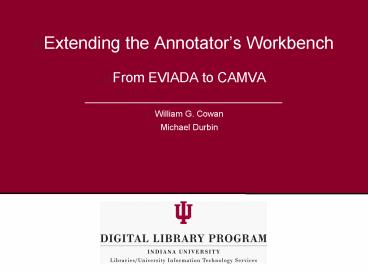Extending the Annotators Workbench - PowerPoint PPT Presentation
1 / 17
Title:
Extending the Annotators Workbench
Description:
Methodology: Leverage tools and experience from EVIA Digital Archive project as ... Video digitized by Central American institutions or local vendors ... – PowerPoint PPT presentation
Number of Views:35
Avg rating:3.0/5.0
Title: Extending the Annotators Workbench
1
Extending the Annotators Workbench
- From EVIADA to CAMVA
- William G. Cowan
- Michael Durbin
2
History of EVIADA and CAMVA
- Ethnographic Video for Instruction and Analysis
Digital Archive (started 2001) - Extensive use of video from field collecting
- Desire to preserve this video
- Ability to annotate this video
- Networked access for research and instruction
- Central America and Mexico Video Archive (started
2005) - Goal Digitize, preserve, and make available
hundreds of hours of at-risk or deteriorating
film and video footage from three Central
American archives - Methodology Leverage tools and experience from
EVIA Digital Archive project as much as possible
3
IU Partners for CAMVA
- Center for Latin American and Caribbean Studies
- Digital Library Program
- Center for the Study of History and Memory
- EVIADA
4
Central American Partners
- El Salvador
- MUPI Museo de la Imagen y la Palabra
- Nicaragua
- IHNCA Instituto de la Historia de Nicaragua y
Centroamerica - Mexico
- CIESAS Centro de Investigaciones y Estudios
Superiore en Antropologia Socíal
5
CAMVA Support
- Grant from the Technological Innovation and
Cooperation for Foreign Information Access
(TICFIA) program of the US Department of
Education - October 1, 2005 September 30, 2009
- Project Director Jeff Gould, CLACS
- Project Manager Mike Grove, CLACS
- UITS Personnel Jon Dunn, Will Cowan
- EVIADA Support Mike Durbin, Shah Akram
- CAMVA Developer Gulshan Patil
6
CAMVA Overview
- Goal Digitize, preserve, and make available
hundreds of hours of at-risk or deteriorating
film and video footage from three Central
American archives - Methodology Leverage tools and experience from
EVIA Digital Archive project as much as possible
7
CAMVA Process
- Video digitized by Central American institutions
or local vendors - Transmitted to IU via Internet or DVDs
- Transcoded to delivery formats at IU made
available via IUs streaming servers and stored
in MDSS / preservation repository
8
CAMVA Software Development
- Starting points
- EVIA Annotators Workbench
- EVIA Web Search Browse Interface
- EVIA Controlled Vocabulary Tool
- Operate within the larger technical environment
at Indiana University - Customize to be more appropriate to needs of CAMVA
9
Some differences between EVIA and CAMVA
- Need for multilingual interfaces for annotation
and access - Need for multilingual metadata, controlled
vocabularies - More varied genres of video
- Video being described by archivists or
catalogers, not the original creator - Less focus on preservation more on access
10
What we didnt want
- Too tightly coupled
- Need to meet the needs of CAMVA
- No flexibility
- Parallel Software Development
- i.e. CAMVA takes existing EVIADA code and does
its own development - Synchronization nightmare
11
What we decided to do
- Extend the Annotators Workbench
- Multilingual - start with Spanish but could be
any language - Flexible window layout - different windows and
different layouts for different workflows - Flexible data entry - different fields for
different uses - New XML Schema supports extended Annotators
Workbench
12
Annotators Workbench B.C. (Before CAMVA)
- DEMO
13
Design and Implementation
- Internationalization
- Modularize the Annotators Workbench
- Determine scope of customizability
- Fields
- Components
- Features
- Create a means of expressing the configuration
- Layout XML Schema
14
Design Considerations Fields
- User interface must gracefully accept arbitrary
inclusion of fields - Largely manual process considering all possible
combinations and looking at the user interface - Entered metadata and annotation must be
preserved, even when not exposed to the user in
the current layout
15
Design Considerations Components
- A generalization of our component configuration
must minimally support the current EVIA layout
and the proposed CAMVA layout - Components can be internal windows or anchored
- Components can have relative sizes or absolute
sizes - Components must fit into an arbitrarily sized
container (the main application window)
16
Design Considerations Components
- Unable to find standard solutions to analogous
formatting problems - Predefined layouts for Java were unsuitable
- HTML doesnt deal with the same issues
- Doesnt seem to be any standard model for this
kind of layout configuration
17
Design Considerations Components
- Final Design
- Anchored components are laid out sequentially in
blocks that are anchored to one side of the
remaining formatting area - Floating components are placed in their
percentage-based position - Minimum sizes for floating component override
layout specification
18
Demo of Annotators Workbench
19
Current and future work
- Video standards defined
- Developer hired (Gulshan Patil)
- Work begun on making Annotators Workbench
multilingual - Meeting with Member Institutions planned for
Spring / Summer 2007 - Define user needs for Annotation Process
- Define user needs for Controlled Vocabulary
- Determine final digital preservation processes































